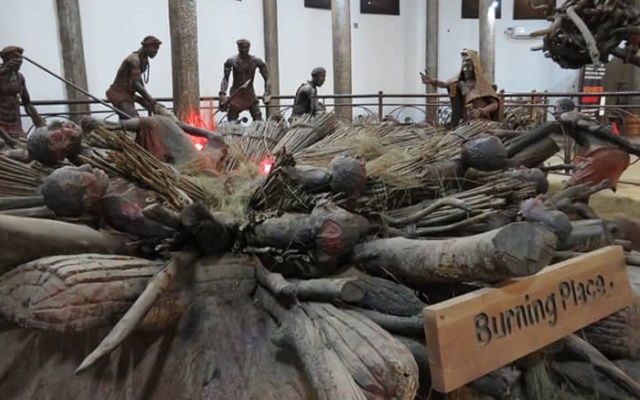
How the ancient concept informs modern religious violence
Kampala, Uganda | THE INDEPENDENT | The word “martyr” has evolved into one of the most emotive terms in the English language. The faithful venerate their memories, celebrate their feast days, name places of worship, schools and hospitals after them.
And yet, those who would claim the title blow themselves up in explosive-laden cars in crowded market-places, eviscerate their own bodies and those around them with bombs in concert halls, turn vehicles into instruments of mass murder and kill and maim with knives and machine guns on city streets.
Many would protest about a terrorist’s claim to the title of martyr. That their act of murderous self-destruction bears no relation to the steadfast, but essentially passive, courage of those persecuted for their beliefs in ages past.
The history of martyrdom is not clear cut. The ideology of martyrdom has always been contested and has long contained a potential to commit violence against others.
The word martyr itself derives from the Greek for “witness”, originally applied to the apostles who had witnessed Christ’s life and resurrection. Later it was used to describe those who, arrested and on trial, admitted to being Christians.
By the middle of the second century, it was granted to those who suffered execution for their faith. Christians were not alone in their admiration of those willing to die for their principles. The philosopher Socrates was unjustly condemned to death in 399 BC for “refusing to recognise the gods” and “corrupting the youth” of Athens.
There was, however, a striking difference between Socrates and those martyred in the arenas. The philosopher hoped for, but was not sure of, an afterlife. The martyr, however, was very certain of an afterlife.
Indeed, the martyr was certain not just of an afterlife but of salvation and reward in heaven. Their example in this belief was the Holy Maccabees, the second-century Jewish family executed for refusing to break Jewish law by the king of Syria, Antiochus Epiphanes. In death, the Maccabees claimed victory and said: “The king of the world shall raise us up those who have died for his laws, unto everlasting life”.
Christian martyrs and ‘volunteers’
Then arose the possibility that those who desired such a reward might volunteer for martyrdom. Roman persecution of Christians, at least before the middle of the third-century, was usually sporadic. Christians were widely despised and scapegoated for natural disasters and urban fires.
Professing the name of “Christian” publicly was dangerous. Some Christians, however, pursued martyrdom. Towards the end of the second-century, Arrius Antoninus, proconsul of the province of Asia, was confronted by “the whole Christians of the province in one united band” who loudly and insistently confessed the name of Christ. Having executed a number without having stifled the clamour, Arrius finally declared: “You miserable wretches, if you want to die, you have cliffs to leap from and ropes to hang by”.
The close relationship between the sinful act of suicide and voluntary martyrdom was a matter of fierce controversy within the church.
St Cyprian, bishop of Carthage, was one critic of voluntary martyrdom but his own story reveals the depth of disagreement among Christians over how to behave in the face of persecution.
In the third-century, successive emperors made efforts to compel all subjects to participate in the sacrificial rituals thought necessary to retain the favour of the gods. Christians who refused became victims of renewed persecution. In 249AD, Cyprian chose exile from Carthage to avoid the authorities, an act some of those who shared his religion regarded as cowardly. Yet Cyprian did not lack courage and accepted his own martyrdom in the arena in 258AD.
The move to terror
It was the deliberate courting of death that was clearly sinful. The worthy would be gifted martyrdom by God. To try and achieve martyrdom by one’s own efforts was an act of defiance. By this time, though, there were those who did not merely volunteer for martyrdom, they provoked it.
They smashed idols, disrupted pagan rituals and assaulted temple priests knowing they would die in the ensuing violence. The ideology of martyrdom had shifted subtly – for some, martyrs did not simply die for God, now they killed and terrorised in his name.
Such beliefs were always contested. Bishops at the Council of Elvira in 300AD firmly decreed that those killed in retaliation for smashing idols were to be denied the name of martyr. Yet bishops had to repeatedly remind militant elements of their congregations of this judgement. A dangerous and persistent tradition had been born.Martyrdom became a shared tradition of the Abrahamic religions – in Hebrew, Kiddush Ha-Shem (sanctification of the divine name); in Arabic, shahada (witness).
For each, however, martyrdom has been a contested concept of shifting definition and legitimacy. Yet martyrdom contains within its history an ancient violent tradition that is now fuelling Islamist terror attacks. As a largely secular society, it may be hard to understand this. Worldly answers to the puzzle of the suicide bomber seem to make more sense: who radicalised them? What role did the internet play in their indoctrination? How have socio-economic conditions fashioned terrorists?
But at least part of the answer to the puzzle concerns the immaterial: the promise of eternal reward in the hereafter. This is a religious question and those with influence among religious communities need to address it. Like the bishops at Elvira they must be clear: the terrorist can be no martyr.
*****
This article was written by Gervase Phillips, then-Principal Lecturer, and Manchester Metropolitan University in 2017.
Source: The conversation
 The Independent Uganda: You get the Truth we Pay the Price
The Independent Uganda: You get the Truth we Pay the Price



